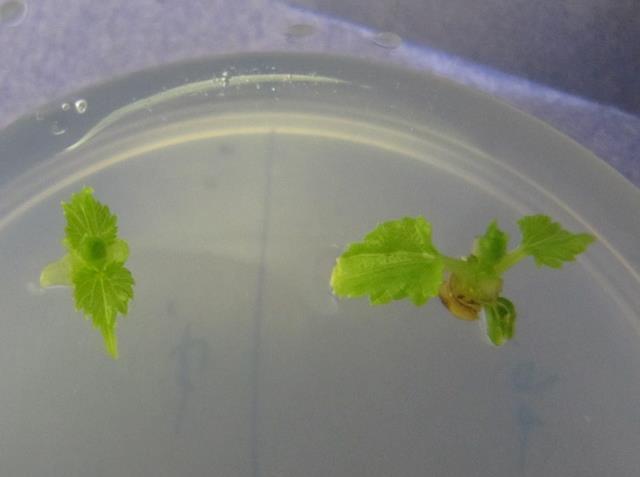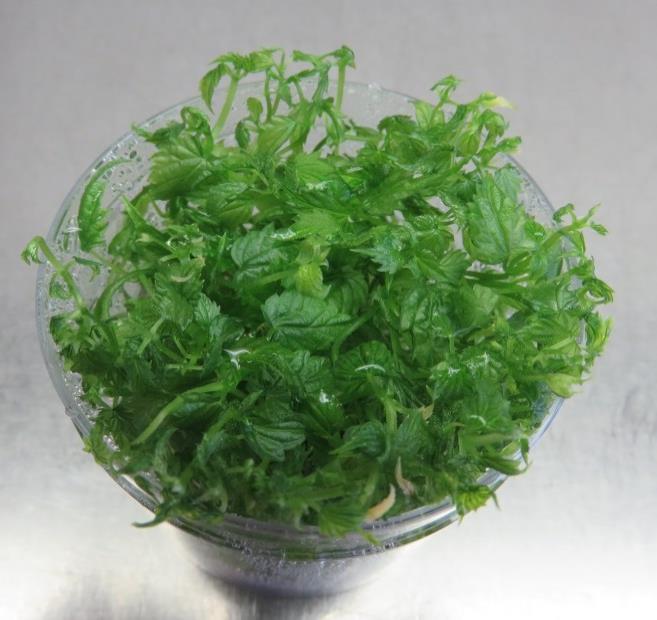
6 minute read
6.8 Meristem culture for the production of healthy seedlings
Outlook
We are constantly working to optimize the real-time PCR method. This involves continuously verifiying that the primers used in the PCR reaction for the detection of Verticillium nonalfalfae can still detect all mild and aggressive versions that occur in the Hallertau.
References
Borza, T., Beaton, B., Govindarajan, A., Gau, X., Liu, Y., Ganga, Z., Wang-Pruski, G. (2018): Incidence and abundance of Verticillium dahliae in soil from various agricultural fields in Prince Edward Island, Canada. Eur J Plant Pathol 151, 2825—2830. https://doi.orgll 0.1007/310658—017—1408-1 EPPO Bulletin (2020) PM 7/78 (2) Verticillium nonalfalfae and V. dahliae: 50 (3): 462-476. Guček, T., Stajner, N., Radišek, S. (2015): Quantification and detection of Verticillium albo-atrum in hop (Humulus lupulus) with real-time PCR. Hop Bulletin 22, 26-39. Maurer, K.A., Radišek, S., Berg, G., Seefelder, S. (2013): Real-time PCR assay to detect Verticillium albo-atrum and V. dahliae in hops: development and comparison with a standard PCR method. Journal of Plant Diseases and Protection, 120 (3), 105–114. Seigner, E, Haugg, B, Hager, P., Enders, R., Kneidl, J. & Lutz, A. (2017): Verticillium wilt on hops: Real-time PCR and meristem culture – essential tools to produce healthy planting material. Proceeding of the ScientificTechnical Commission of the International Hop Growers´ Convention, Austria, 20-23. Wei, F., Fan, R., Dong, H.-T., Shang, W.-J., Xu, X.-M., Zhu, H.-Q., Yang, J.-R., and Hu, X.-P. (2015): Threshold microsclerotial inoculum for cotton Verticillium wilt determined through wet-sieving and real-time quantitative PCR. Phytopathology 105:220-229. Weller, S.A., Elphinstone, J.G., Smith, N.C., Boonham, N., and Stead, D.E. (2000): Detection of Ralstonia solanacearum strains with a quantitative, multiplex, real-time, fluorogenic PCR (TaqMan) assay. Appl Environ Microbiol. 66(7), 2853-8.
6.8 Meristem culture for the production of healthy seedlings
Project Management: Dr. E. Seigner, A. Lutz Team: B. Haugg P. Hager, R. Enders, IPZ 5c Collaboration: Dr. L. Seigner, and the Virus Diagnostics Team, IPS 2c
Objectives
Infestations of Verticillium, viruses, and viroids can lead to dramatic losses in yield and quality. Since these diseases cannot be combated with pesticides, a biotechnological method, such as meristem culture, is used to produce Verticillium- and virus-free material. In 2020, the main focus was on improving the method for eliminating apple mosaic virus (ApMV), which is often more stubborn than the hop mosaic virus and can still be detected in regenerated plants, even after a meristem culture intervention.
Method
To produce Verticillium- and virus-free hop plants, the meristem (the uppermost growth zone of the tip of the shoot) of an infected plant grown in the greenhouse is surface-sterilized and then treated with heat in vitro for several days (see Figure 6.9). It is assumed that existing viruses and fungal structures in the meristem are inactivated. After the heat therapy, the meristem is prepared under a binocular. It is then placed on a special culture medium and finally regenerated into a complete plant in vitro (see Figure 6.10 A-C). To confirm the successful elimination of viruses and Verticillium via the meristem step, the mature plants are examined for these at the end of the tissue culture phase. The leaves are examined by the Working Group IPS 2c for various hop-typical viruses and in some cases also for viroids using the DASELISA (Double Antibody Sandwich Enzyme Linked Immunosorbent Assay) technique or the RT-PCR (Reverse Transcriptase Polymerase Chain Reaction). Only healthy little plants are finally placed in the soil (Figure 6.10 D).
Results
In 2020 there were no Verticillium-infected hops ready for release. Therefore, the focus was on virus elimination. This opened an opportunity to also improve the method for eliminating especially “persistent” viruses, such as the apple mosaic virus (ApMV). Also considered were the effects of different heat therapies and different sizes of the prepared meristems on the elimination rate of viruses, especially of ApMV. To clear out the virus, the shoot tips were first subjected in vitro for three days to heat adaptation phase at 30 °C, followed by a heat therapy for five to 11 days at 35 °C. The longer the heat phase lasted, the more stress-related effects (yellowing, browning) became visible in the vitro-treated shoot tips (Figure 6.10), which ultimately also had a negative effect on the regenerative capacity of the meristems.
Figure 6.9: Shoot tips of ApMV-infected hops were subjected to heat therapy for 8 (A), 10 (B) and 14 (C) days (3 days @ 30 °C plus 5, 7, or 11 days at 35 °C). The longer the heat treatment lasted, the more obvious became the browning. Despite the poor external appearance of the shoot tips after 14 days, the meristems were still viable and capable of regeneration.

A B


C D

Figure 6.10: Regeneration of the little plants created from the meristems A) 3 weeks after preparation and still on solid medium in the Petri dish; B) 10 weeks after preparation in the RITA® liquid culture system; C) after an in vitro cloning step, five months after preparation of the meristems in a culture box with solid medium; and D) 9-10 months after the start of the meristem culture in soil.
On the other hand, a longer heat phase (10- and 14-day heat treatment) resulted in higher virus elimination rates. The results from 2020 demonstrated that an extention of the the 35-degree phase from three days (the time frame used up to 2016) to seven or even 11 days increased the elimination rate of ApMV from 55% (2010 to 2016) to 80% (additional results are pending). In 2018 and 2019, a wide variety of temperature schemes were tested that had been used successfully for virus or viroid elimination in hops and in other crops, as, for example, by Postman et al. (2005), Matoušek et al. (1995 and 2001), Faltus et al. (2011) and Kazemi et al. (2020). In these tests, either no effect on the elimination of the viruses could be observed, or the regeneration of the meristems into small plants was completely thwarted by excessive stress. For the size of the prepared meristems, a diameter of 0.3 to 1.0 mm was used. Preparations of about 0.5 mm proved to be optimal in terms of regenerative capacity and the virus elimination rate. In principle, the smaller the initial meristem (0.3 to 0.4 mm), the higher was the virus
elimination rate, but only very few of these plants could also be regenerated from the smallest meristem preparations.
Outlook
Work is underway to further increase the virus elimination rate by optimizing the regeneration of meristems. Viroid infestations, in particular, pose a major challenge and truely effective methods are still lacking. Therefore, new approaches to viroid elimination or inactivation are being pursued.
References
Faltus, M., Zamecnik, J., Svoboda, P., Patzak J. and Nesvadba, V. (2011): Progress in the Czech Hop Germplasm Cryoconservation. Acta Hort 908: 453-460. Kazemi, N., Nahandi, F.Z., Habashi, A.A., Masoomi-Aladizgeh, F. (2020): Comparing the efficiency of conventional and novel methods of virus elimination using molecular techniques. European Journal of Plant Pathology 157 (4), 887-897. Matoušek, J., Trněná, L., Svoboda, P., Oriniaková, P., Lichtenstein, C.P. (1995): The gradual reduction of viroid levels in hop mericlones following heat therapy. Biol. Chem. Hoppe-Seyler 376: 715–721. Matousek, J., Patzak, J., Orctová, L., Schubert, J., Vrba, L., Steger, G., Riesner, D. (2001): The variability of hop latent viroid as induced upon heat treatment. Virology 287(2):349-358. Postman, J., DeNoma, J. and Reed, B.M. (2005): Detection and Elimination of Viruses in USDA Hop (Humulus lupulus) germplasm collection. Acta Hort. 668:143-148. Seigner, E, Haugg, B, Hager, P., Enders, R., Kneidl, J. & Lutz, A. (2017): Verticillium wilt on hops: Real-time PCR and meristem culture – essential tools to produce healthy planting material. Proceeding of the Scientific-Technical Commission of the International Hop Growers´ Convention, Austria, 20-23.









